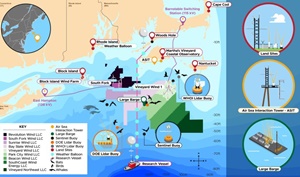 The U.S. Department of Energy (DOE) and the National Oceanic and Atmospheric Administration (NOAA) have launched an 18-month initiative to gather extensive weather, ocean, and wildlife data near the sites of active offshore wind farms and lease areas off the coast of the Northeast United States.
The U.S. Department of Energy (DOE) and the National Oceanic and Atmospheric Administration (NOAA) have launched an 18-month initiative to gather extensive weather, ocean, and wildlife data near the sites of active offshore wind farms and lease areas off the coast of the Northeast United States.This effort, which is part of the third phase of the Wind Forecast Improvement Project (WFIP3), seeks to gather high-quality data to improve the design and operation of offshore wind turbines and wind farms. The collected data will be publicly available and used to inform responsible offshore wind siting, weather forecasting, and grid integration, as well as support advancements in weather and wind plant modelling. To ensure the coexistence of offshore wind deployment with ecosystems and other ocean users, WFIP3 platforms are also being used to monitor wildlife, including whales, birds, and bats.
Upon completion of the data collection campaign, the monitoring platforms and instruments will be removed from the ocean, and the study's data and results will be published and used to improve the accuracy of weather forecasts for the region.
WFIP3 is funded by DOE and NOAA and led by the Pacific Northwest National Laboratory and Woods Hole Oceanographic Institution, with over 15 partners including national laboratories, universities, industry, and cooperation from local governments. The wildlife monitoring is a project of Duke University with funding from DOE and the Bureau of Ocean Energy Management.
(Image by Stephanie King Pacific Northwest National Laboratory)








